- medicalnewstoday.com - What are hives (urticaria)?
- nhsinform.scot - Urticaria (hives)
- ncbi.nlm.nih.gov - Chronic urticaria
- ncbi.nlm.nih.gov - Diagnosis and treatment of urticaria in primary care
- Jafilan, L; James, C (December 2015). "Urticaria and Allergy-Mediated Conditions". Primary Care. 42 (4): 473–83.
- Zuberbier, Torsten; Grattan, Clive; Maurer, Marcus (2010). Urticaria and Angioedema. Springer Science & Business Media. p. 38.
- Griffiths, Christopher; Barker, Jonathan; Bleiker, Tanya; Chalmers, Robert; Creamer, Daniel (2016). Rook's Textbook of Dermatology, 4 Volume Set (9 ed.). John Wiley & Sons. p. Chapter 42.3. ISBN 9781118441176.
- A Dictionary of Entomology. CABI. 2011. p. 1430. ISBN 9781845935429.
- Fraser K, Robertson L (Dec 2013). "Chronic urticaria and autoimmunity". Skin Therapy Lett (Review). 18 (7): 5–9.
- "Prescribing Information Dexedrine". GlaxoSmithKline. June 2006.
- Alexander A. Fisher (2008). Fisher's Contact Dermatitis. PMPH-USA. ISBN 9781550093780.
- Tebbe, Beate; Geilen, Christoph C.; Schulzke, Jörg-Dieter; Bojarski, Christian; Radenhausen, Michael; Orfanos, Constantin E. (1996). "Helicobacter pylori infection and chronic urticaria". Journal of the American Academy of Dermatology. 34 (4): 685–6.
- Kolkhir, P.; Balakirski, G.; Merk, HF.; Olisova, O.; Maurer, M. (December 2015). "Chronic spontaneous urticaria and internal parasites – a systematic review". Allergy. 71 (3): 308–322.
- Jedele, Kerry B.; Michels, Virginia V. (1991). "Familial dermographism". American Journal of Medical Genetics. 39 (2): 201–3.
- Kontou-Fili, K.; Borici-Mazi, R.; Kapp, A.; Matjevic, L. J.; Mitchel, F. B. (1997). "Physical urticaria: Classification and diagnostic guidelines". Allergy. 52 (5): 504–13
Hives: Causes, Symptoms, Treatment
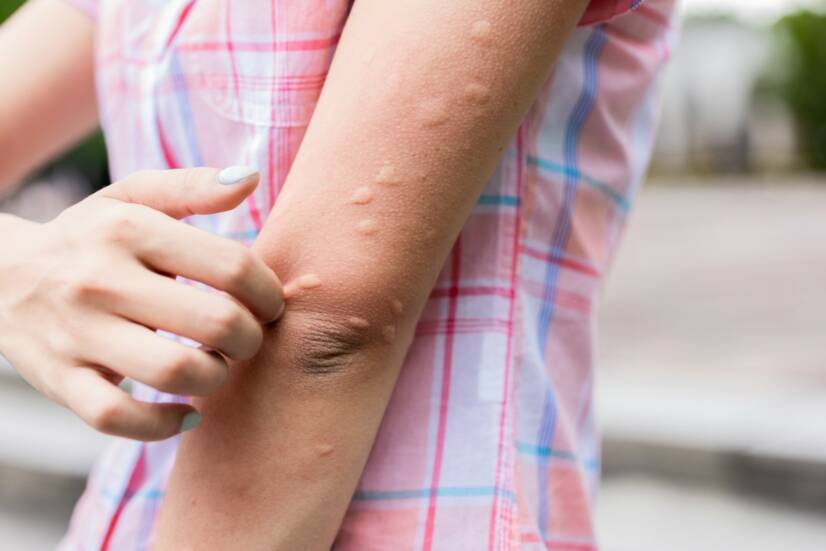
Hives are among the 20 most common skin diseases. Approximately 20-30% of people have had the disease at least once in their lifetime.
Most common symptoms
- Joint Pain
- Skin pain
- Hoarseness
- Increased body temperature
- Spirituality
- Nausea
- Diarrhoea
- Rash
- The Island
- Blisters
- Buds
- Itchy skin
- Fatigue
- Reddened skin
Characteristics
Hives (urticaria) is a skin disease with a prevalence in both children and adults.
Hives is not a communicable disease.
Several factors are involved in its occurrence. Symptoms of the disease can appear anywhere on the body. The classification of urticaria is not uniform and can be divided according to localization, time course or character.
Table: Overview of types of urticaria
| TYPE OF URTICARIA | CHARAKTERISTICS AND CLASSIFICATION |
| Acute urticaria |
|
| Chronic urticaria |
|
| Physical urticaria |
|
| Adrenergic urticaria |
|
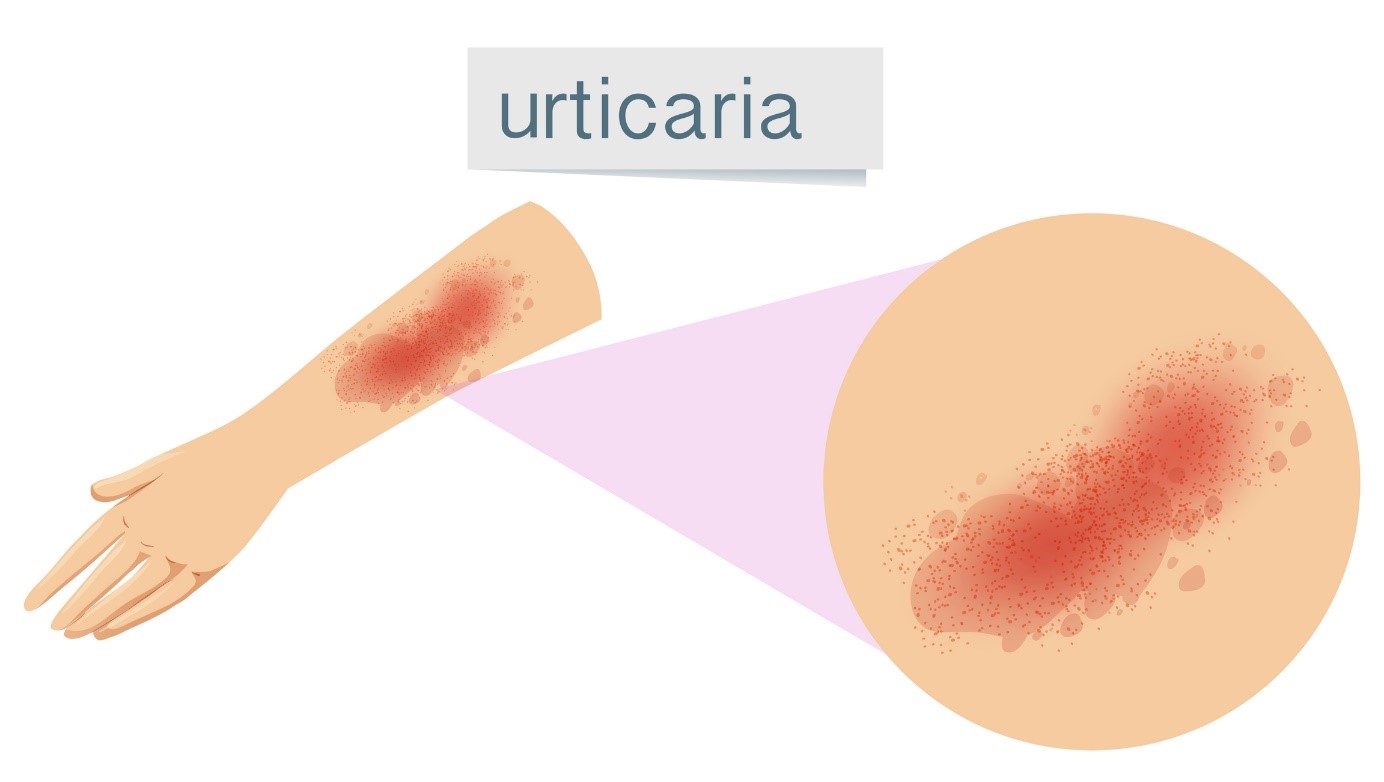
A. Acute urticaria
Acute urticaria occurs mainly in children.
Almost 15% of people have experienced this form of urticaria at least once in their lifetime.
Manifestations of the disease arise suddenly and usually disappear within 20-120 minutes. In the meantime, other rashes appear elsewhere. Acute urticaria tends to recede completely within 3 weeks.
Acute urticaria can be accompanied by:
- angioedema
- bronchospasm
- slightly elevated temperature
- nausea
- vomiting
- symptoms of shock
B. Chronic urticaria
Chronic urticaria mainly affects adults.
It can persist for months to years.
Typical manifestations include rashes and/or angioedema. Rashes are manifested by a central swelling of varying size, almost always with a reddened rim. The manifestations are associated with itching, sometimes burning, absorbed within 24 hours without trace.
Angioedema represents a sudden swelling of the lower dermis and hypodermis, with frequent occurrence on mucous membranes. Angioedema usually resolves within 72 hours. Patients complain of itching and soreness.
Chronic spontaneous urticaria can be triggered by autoimmune reactions or unknown causes.
C. Physical urticaria
Physical urticaria is provoked by various stimuli. In practice, it occurs in almost 20% of patients suffering from urticaria.
1. Aquagenic urticaria
This type of urticaria is very rare. Rashes appear after prolonged skin contact with water. Small rashes appear within 2 - 30 minutes at the site of water contact and cause an itching sensation.
2. Dermographic urticaria
It is characterized by a streaky or band-like redness and skin reactions at sites of clothing friction, scratches, or abraded skin. Patients often complain of marked itching in the morning on rising or during sleep. The course of dermographic urticaria is chronic in most cases.
3. Cholinergic urticaria
The disease occurs after increased body temperature and overheating of the body during physical exertion, sports or stress. It manifests itself mainly on the upper part of the trunk. Small itchy, whitish rashes appear.
4. Cold-induced urticaria
Cold urticaria is caused by cold air, water or cold drinks.
Cold-induced urticaria can be a concomitant sign of another disease (drug allergy).
It is manifested by local or systemic formation of small rashes, rarely by oedema and general reaction of the body.
There are two types of cold-induced urticaria:
• Contact urticaria
It develops on areas of the skin that have been exposed to direct exposure to cold. It occurs mainly in the winter seasons.
Symptoms of the disease are manifested mainly on the uncovered parts of the body (face, neck, hands). The contact type is characterised by the appearance of itchy rashes and redness.
• Reflex urticaria (distant urticaria)
It occurs in places that have not been directly exposed to cold.
An example of the reflex type of urticaria is the consumption of cold foods or drinks.
5. Contact urticaria
This type of urticaria arises only after contact with the allergen. It occurs only at the site that has been directly exposed to the allergen. As a rule, the redness is asymmetrical and circumscribed.
Contact allergens include:
- animal allergens (bee, wasp venom, caterpillar hairs, jellyfish).
- plant allergens (pollen).
- foods (potatoes, asparagus, onions, citrus fruit peels).
- medicines
- cosmetics (hair dye containing paraphenylenediamine, black henna).
- working substances (formaldehyde, resorcinol, iodine, cobalt).
- latex
6. Solar urticaria (sun-induced hives)
This disease mainly affects women (60%). The age of patients ranges from 20 to 40 years.
Solar urticaria is in most cases triggered by sunlight. Sometimes fluorescent bulbs, UV-A emitters in tanning salons, halogen emitters, lighting sources in beauty salons and in the film industry can be the cause.
The first manifestations (itching, redness, burning) appear within a few minutes after exposure. Rashes may form after a few hours. In addition to the skin manifestations, the patient may suffer from headache, fatigue, nausea and dizziness.
7. Heat-induced urticaria (heat urticaria)
This form of urticaria is extremely rare. It is provoked by direct external action of heat or heat on the skin.
Within minutes, redness develops on the skin with typical small itchy rashes.
Urticaria with temperature change can occur after moving from a cold to a warm environment. After a few minutes, intense itchy rashes appear on the body.
8. Pressure urticaria
It occurs after a single blow, impact or pressure at the site of irritation (standing, walking, sitting on a hard chair). Pressure urticaria manifests itself as a reddened, deeper, occasionally painful swelling.
Often the manifestations are accompanied with general flu-like symptoms.
Causes
A common feature of most types of urticaria is the activation and degranulation of mast cells.
Activation of mast cells leads to the release of mediators (histamine, serotonin, bradykinin, eicosanoids: leukotrienes, prostaglandins, basophils, proteolytic enzymes) into the surroundings. These cause vasodilatation and an increase in the permeability of the vessel wall.
Such a mechanism produces redness, edema and rashes. The formation of urticaria and the release of histamine from mast cells can occur from a variety of causes.

Table: possible causes
| Cause | Mechanism of formation |
| Idiopathic cause (unknown cause) | In approximately 30-50% of patients, even after adequate investigations, we are unable to determine the underlying cause of urticaria. |
| Immunological cause |
Proxies:
|
| Non-immunological cause |
|
IgE - Stands for immunoglobulins E, which are antibodies that some people develop in the body in response to various allergens.
Mastocytes - Mast cells containing histamine and other enzymes, which are found in the skin or internal organs, participate in the allergic reaction.
Basophils - They are blood cells that are not found in tissues but migrate to the inflammatory focus in pathological conditions.
Immunological causes
In this case, medicines, foods and reagents or excipients in them come into consideration. Also, metabolic disorders, autoantigens (malignant tumors) and emotional factors may be the cause.
In the case of immunocomplex urticaria, the mediator is released directly by degranulation of mast cells without histamine action. The reaction takes place via the complement system. Manifestations appear with some delay after exposure to the allergen.
The provoking factor may be medication (8th-12th day after starting the drug) or an autoimmune disease.
What is the complementary system?
The complement system is made up of more than 35 proteins produced mainly by the liver and macrophages, allowing it to be activated anywhere in the body where inflammation is taking place.
It is part of a non-specific humoral immune response.
The proteins of the complement system are in an inactive state in the body and their activation takes place gradually. As soon as one component is activated, it subsequently activates the other, and so on. This sequential activation triggers the immune response.
Non-immunological causes of urticaria
Very many drugs and diagnostic agents can trigger reactions that resemble an early allergic reaction, including acute urticaria.
Non-immunological causes include:
- Medicines, anaesthetics and anticholinergics - opiates (morphine), thiopental, atropine, papaverine
- X-ray contrast agents - derivatives of triiodobenzoic acid.
- Acetylsalicylic acid and other antiphlogistics.
- Antibiotics - chlortetracycline, polymyxin.
- Vitamin B1
- ferrous salts
- Food additives - preservatives, colouring agents and flavour enhancers.
What are the causes of acute urticaria?
The most common causes of acute urticaria are bacterial, viral, mycotic and parasitic infections.
At different ages, there are different factors that provoke urticaria:
in young children, the most common cause is infection or food,
in adults, the use of medication.
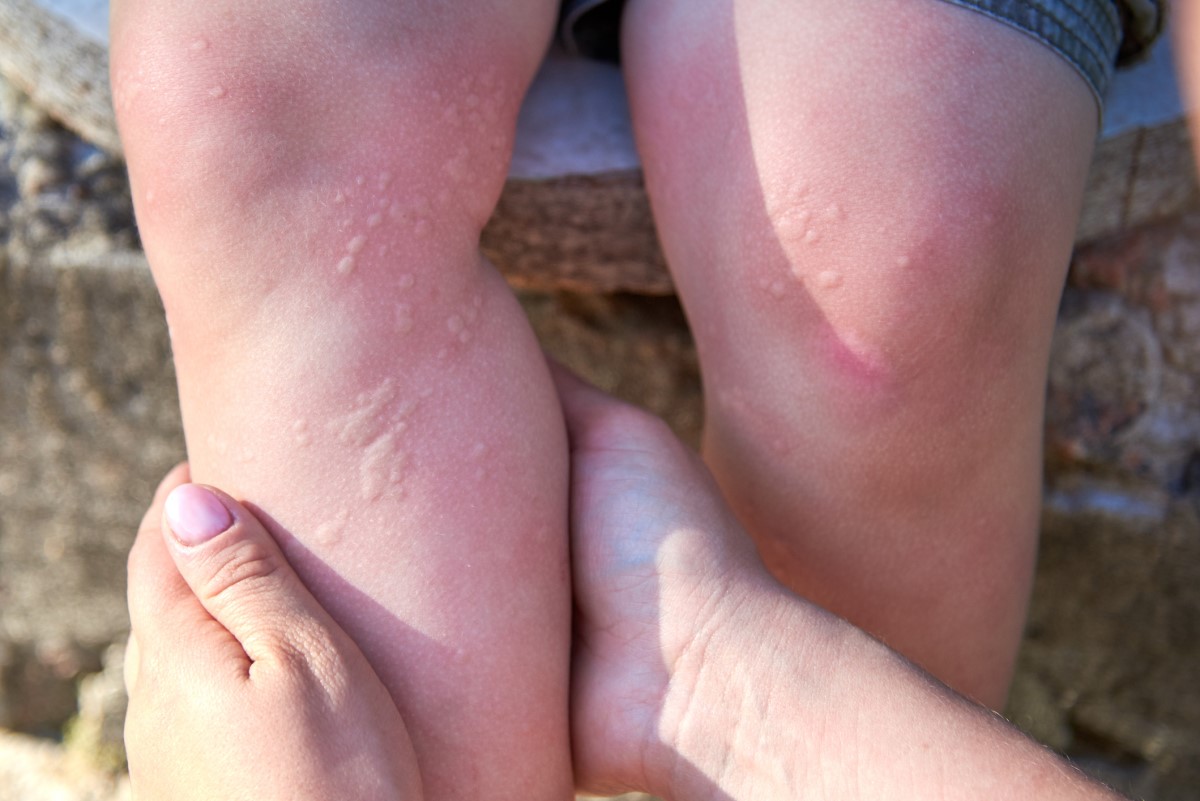
The most common causes of acute urticaria include:
- fish, crayfish, crabs, clams, oysters,
- meat - mutton
- cheeses - especially those containing moulds
- fruit - strawberries, gooseberries, walnuts, citrus fruits, kiwi
- vegetables - legumes, tomatoes, celery, dill
- spices
- foreign substances after insect bites
- medicines - salicylic acid, antibiotics (penicillin, cephalosporins), hypnotics, barbiturates, analgesics
- vitamins – B1 and B 12
What are the causes of chronic urticaria?
The causes of chronic urticaria are diverse and often unexplained.
Chronic urticaria can be caused by type I, type III allergic reactions or idiosyncrasy (increased sensitivity to certain substances). Allergens can appear in the body as a focal infection, in digestive tract disorders, in unexplained yeast or mycotic infections, and in the presence of parasites in the body.
We also have to consider a reaction on the basis of autoimmunity.
Chronic urticaria can occur with vasculitis (inflammation of blood vessels) and other autoimmune diseases, but psychological influences are also not excluded.
Approximately 50% of patients suffering from chronic urticaria fail to identify the causes of their urticaria.
Specialists have developed a list of questions designed to trace the cause of urticaria. The following table lists the individual points that can help doctors clarify the cause of the disease.
Table: Questions
| onset of symptoms | association with physical influences or exercise |
| frequency and duration of rashes | taking medication |
| shape, size and distribution of rashes | the association of rashes after eating |
| progress during the day | relationship to the menstrual cycle |
| the presence of angioedema | smoking |
| family and personal history of urticaria and atopy | employment |
| allergies, infections, internal diseases | leisure activities |
| psychiatric illness | stress |
| implants, endoprostheses | quality of life in relation to urticaria symptoms |
| indigestion | previous treatment of urticaria |
Symptoms
The primary manifestation of urticaria is itchiness, edema (swelling), flat and sharply demarcated rashes (acne, pimples).
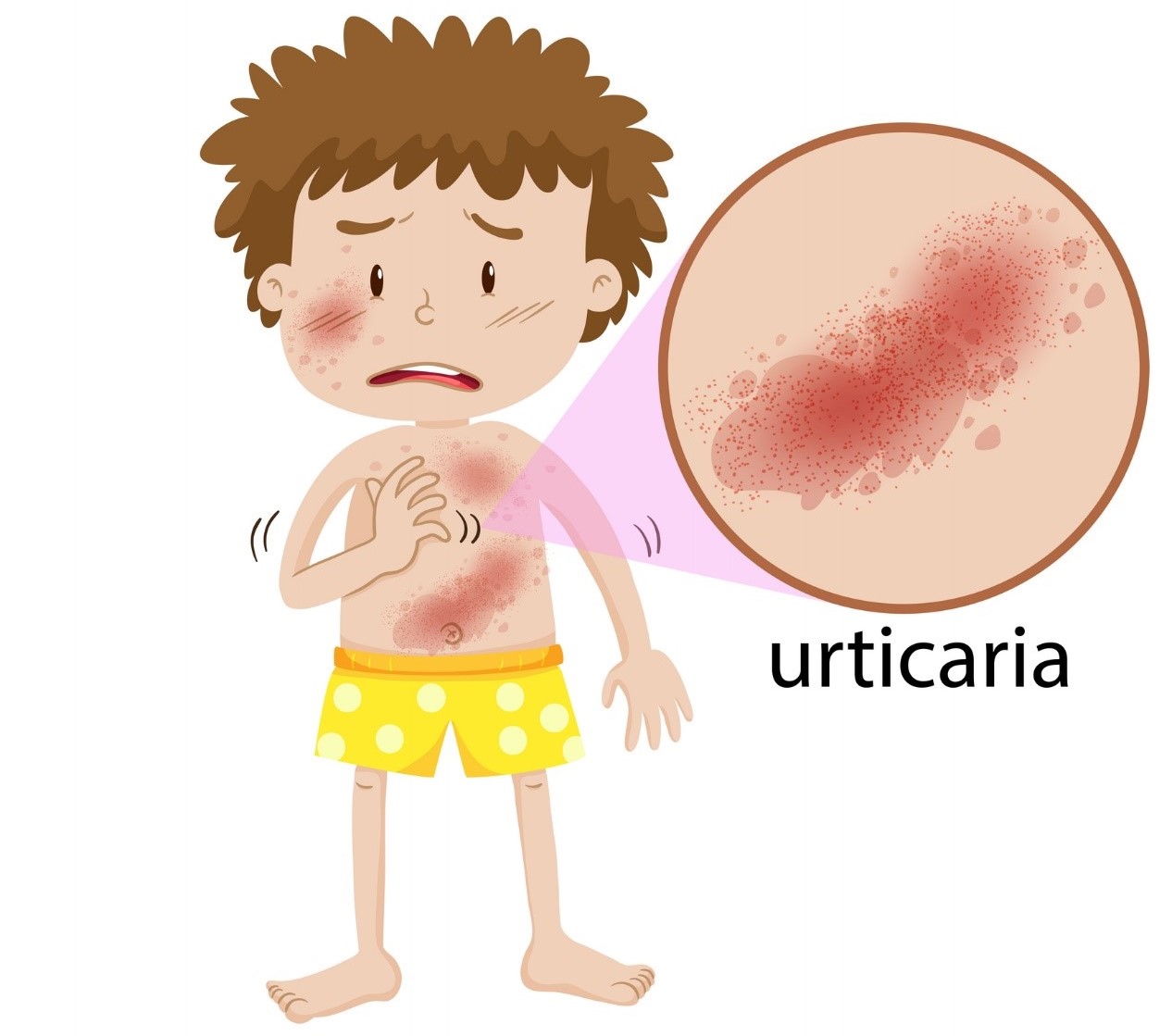
Sometimes the rashes are surrounded by a variably wide, sometimes mottled bright red erythema (red discoloration of the skin caused by inflammation).
Rashes can vary in colour, size and shape.
They are usually bright red in colour, but may also have a whitish anaemic colouration. Size may be that of a pinhead, a lentil, or even flat deposits.
Rashes appear, as a rule, within a few minutes. Their persistence depends on the absorption of histamine. With rapid absorption of histamine, the manifestations of urticaria disappear after only 20 minutes.
In general, the manifestations of urticaria subside after a few hours (3 - 8 hours).
The characteristic feature is intense itching (pruritus), which is particularly unpleasant during the period of rash formation. Later, the itching is relieved.
Itching intensifies especially in the evening.
Urticaria may be accompanied by angioedema, which manifests as an acute, non-tender swelling of the skin. If the mucous membranes of the respiratory tract and digestive tract are affected, difficulty breathing, rales and diarrhoea may occur.
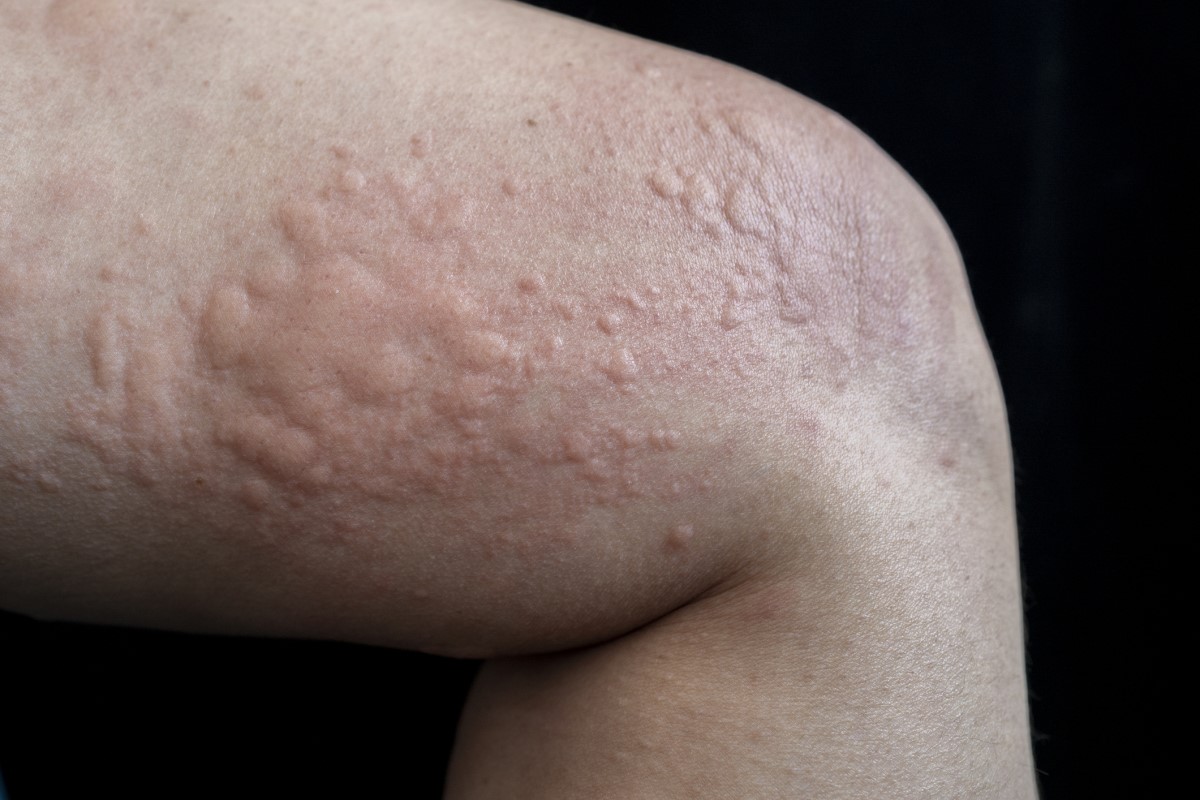
In some cases, the disease is manifested by general nausea, vomiting and can develop into anaphylactic shock.
Anaphylaxis is characterised as a maximally exacerbated version of an allergic reaction that affects the entire human organism. The cause of anaphylaxis is an allergen circulating in the blood.
Anaphylactic reaction intensity classification scale:
Stage 1 – itching, redness, pimples and angioedema are present on the skin.
Stage 2 - includes the association of vomiting, spasms of the gastrointestinal tract, nasal secretions, hoarseness, tachycardia, a drop in pressure of more than 20 mmHg, arrhythmia.
Stage3 – manifested by vomiting, spontaneous defecation, laryngeal oedema, pulmonary oedema, bronchospasm and cyanosis, pressure drop and shock.
Stage 4 - is characterized by respiratory and cardiac arrest, leading to death without therapeutic intervention.
The onset of an anaphylactic reaction often manifests itself on the skin and is a source of important information for the experienced practitioner (itching sensation on the palms of the hands, soles of the feet and the tip of the nose or tongue).
Diagnostics
The basis of the diagnosis of urticaria is the typical picture of itchy rashes and soft tissue edema.
The primary goal of urticaria diagnosis is to identify the triggering factor. To achieve a correct diagnosis, the doctor needs to establish a detailed medical history, conduct basic inflammatory, hematological and biochemical examinations (including parasitological and microbiological).
The main features of the differential diagnosis of urticaria and other skin diseases that have similar symptoms are listed in the table below.
Table: signs of urticaria and urticaria-like diseases
| MANIFESTATIONS TYPICAL OF URTICARIA | URTICARIA-LIKE MANIFESTATIONS |
| itching | itching may or may not be present |
| asymmetric distribution | symmetric distribution |
| rapid retreat (within 24-36 hours) | persistent (even more than 36 hours) |
| associated with soft tissue angioedema | without associated soft tissue swelling |
| without other accompanying lesions | retreatment with residual lesions (scars, hyperpigmentation) |
| other skin manifestations (scales, crusts, vesicles) are also present |
One of the urticaria-like diseases is pruriginous urticarial papules of pregnant women.
They appear in the third trimester (from the 35th week of pregnancy) or soon after delivery.
At first, small rashes appear most often on the abdomen and limbs. Later, eczematous changes form on the surface. Within a few months, the manifestations completely disappear.
Course
The course of urticaria can be different.
Table: distribution of urticaria by course
| FORM | CHARAKTERISTICS |
| Acute |
|
| Chronic-intermittent |
|
| Chronic |
|
How it is treated: Hives
Treatment of urticaria: Medication and topical treatment and home remedies
Show moreHives is treated by
Other names
Interesting resources
Related










